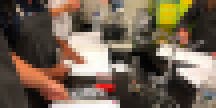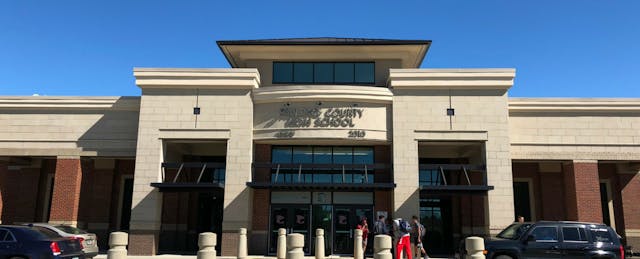“Is it going to explode?” I asked the group of goggle-wearing students as one places a beaker into the microwave. I take two steps back, aware of the fact that I am not wearing goggles.
“If we did everything right, then hopefully not,” one student replies.
“Things don’t usually explode in Biology,” chimes another goggle-wearing student with long blond hair to my left. “That usually happens in Chemistry.”

At Paulding County High School in Dallas, Georgia, science classes are messy and alive. Each corner is full of something growing, stored or experimented on. Greenhouse lights keep vegetables growing in one corner while fruit flies for genetic experimentation squirm in another. Tables are covered with high-tech laboratory equipment such as atomic absorption spectrometers, autoclaves, and laboratory water baths.
What makes the place truly unique, however, is the way Marc Pedersen and his wife Tricia Pedersen have set up their classes to offer students a differentiated, high-tech, personalized learning experience—all without relying heavily on screen time.
Marc Pedersen leads the biotechnology career pathway classes at Paulding County High School, a magnet school in Georgia about one hour away from Atlanta. A former wildlife biologist and lecturer at the University of Wisconsin, he has been teaching since 2005. Over the last 12 years, Pedersen has completely transformed his classroom, making it a model for other educators in the region and winning accolades (including a 2016 Presidential Award for Excellence in Mathematics and Science Teaching). In 2012 when the magnet program was created at Paulding, Pedersen established the high school’s first biotechnology class.

“I tell people, there was a small thing missing in teaching for me, it was research. Now that is filled,” says Pedersen in an interview with EdSurge. “I am learning with the students. What they are doing is incredible.”
Unlike the typical public high school, this program is selective, meaning classes are much smaller. Students must be high achievers in middle school with recommendations from math and science teachers, in addition to high test scores. Of the nine district middle schools, which produce approximately 7,000 kids a year, only 140 made the cut and applied to the school. Out of those who applied, the school accepted 60—leaving them with a crop of smart, enthusiastic, high-achieving group of students. Through the school says it doesn’t factor socio-economic status into the acceptance process, about 60 percent of the student are eligible for free or reduced lunch.
Pedersen says when he started the program he couldn’t find much in terms of curricula or materials from the state of Georgia. He built most of what he does now from scratch on a tight budget.
“I always joke and say back in 2012 we didn’t have an autoclave, so we were crushing bouillon cubes to make microbacteria media and being creative with microwaves, and it worked,” explains Pedersen. “It got the students engaged and doing something as opposed to saying, ‘Well I can’t do that because I don’t have an autoclave.’”
Pedersen chose to model his high school program after graduate schools, meaning students are heavily involved in research and discovery. Students take an Introduction to Healthcare course before entering his Essentials of Biotechnology class. In that class, two students choose a peer-reviewed article and lead seminars every Friday. They are not expected to be experts on the topics, but they are expected to lead the learning process for themselves and their peers.
“You should hear them have these scholarly discussions,” Pedersen says, the pride is visible in his eyes.
In the next course, Applications of Biotechnology, students continue discussions over peer-reviewed literature and engage in lab practicals, something Pedersen notes most high school students know little about. Then when students complete the pathway courses, they are invited to Pedersen’s research classes. His research classes recently grew from 13 students to 35 over the last year.

Pedersen says the class is stressful because he allows each group to do a biotech research project based on their interest, something his students have emphasized makes the course a success.
“It’s a logistical nightmare for me,” admits Pedersen. “If you talk to any of those students. That is my hardest class to teach.”
Allowing 35 students to pick their own research projects requires more than Pedersen’s attention. It requires funding, so the students can get the materials they need. This is why Pedersen has now begun teaching his students how to apply for research grants, and how to reach out to particular scientists and facilities to get what they need. This year they raised about $3000 in funding. His students have received a bacteria strain from a professor in Germany for free, something that would normally cost about 300 dollars.
“I want to be able to fund what they need. The money in high school, at the beginning of the year, you spend it or lose it, but what can I do when, today, for example, a student comes up and says, ‘I need this free agent,’” Pedersen asks.
Pedersen’s students choose projects from all across the science spectrum, including but not limited to health, agricultural and environmental sciences. Then each topic gets intertwined with biotechnology.
“I have a student that has epilepsy and came across a project idea with this one strain of yeast. The way the molecules worked inside the yeast was similar to the way the synaptic vesicles work inside the brain, and so he had to have it. Now he has the yeast,” Pedersen explained. “So now he’s studying epilepsy and antiepileptic drugs, using the model yeast.”
They make a point to de-emphasize grades and tests, removing all high stakes tests and assessments apart from the state’s End-of-Pathway assessments. Pedersen says the lack of testing allows more time for laboratory experimentation. Students in his research classes are assessed when they enter into the regional science fair, where 13 of his students took home 7 of the 20 trophies last year. They are also expected to enter other national and regional competitions. The students are not graded based on where they place in the competition, but instead on the expectation that they should create projects of high-quality that can compete. They are graded on a pass or fail basis.
There are other highly personalized STEM programs similar to the Paulding County High School program in Georgia. According to the Georgia Department of Education website, there are about 11 STEM/STEAM certified schools in Georgia. Rockdale Magnet School for Science and Technology, another STEM school in the region, also runs a popular program in their area where students are able to direct their own learning through projects and research.

Rockdale Magnet School has a one-to-one program, offering each student their own device, Paulding County High School does not, but students do have access to computer labs and laptops. However, both programs offer students high-tech personalized learning experiences, without hours of screentime—something researchers are studying with a wary eye. Instead, their students do lots of hands-on work. If you enter a classroom, some students may be standing over microscopes and taking photos of what they were observing through their cell phones while others spent a good deal of time managing equipment most adults outside of a laboratory have never heard of.
Dr. Robin Davis, the director of Paulding County's careers pathways programs, told EdSurge that the quality of the programs rests on the drive and ambition of the teachers.
“The teachers spend a great deal of time before and after school allowing their students to come in a study, work on projects, and or remediate if needed,” says Davis. “If you don't have teachers with that kind of commitment, I don't think the programs would be as successful.”


